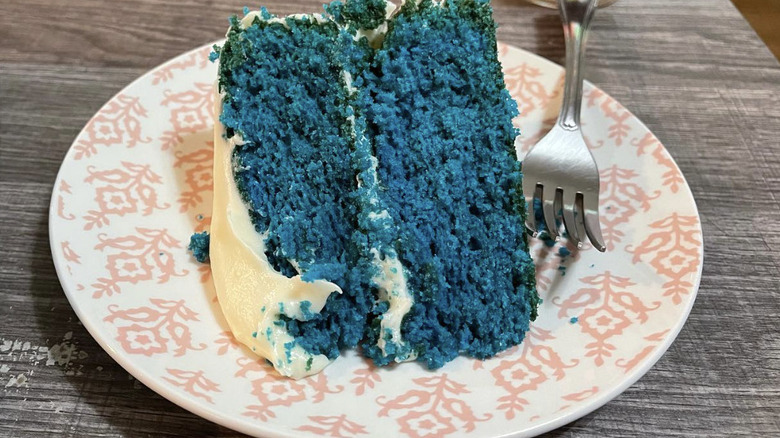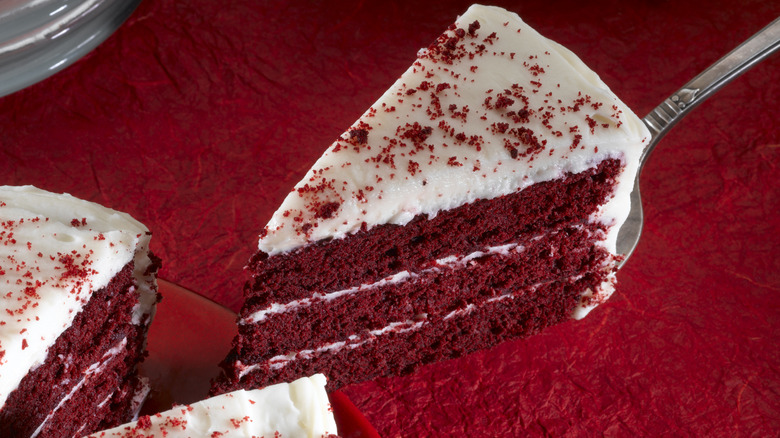Red Velvet Vs. Blue Velvet: The Real Difference Between The Two Cakes
Red velvet cake is a classic dessert that most of us are very familiar with. However, what some people might not be so familiar with is something called blue velvet cake. Like red velvet cake, blue velvet cake is a moist cake served with a light (typically cream cheese or ermine) frosting. It's made with food coloring to give it a distinct appearance.
However, while it's true that these cakes have a couple of key similarities, they also have quite a few differences. As you can probably guess from the name, one of the most obvious differences is their color. Red velvet cake has a bright red color to the cake, while blue velvet cake has a Cookie Monster hue.
Still, there's a bit more to know about the differences between red velvet and blue velvet cakes than just their color. Here's a deep dive into what makes each of these cakes unique, from their ingredients list to their backstories.
The ingredients in red velvet vs blue velvet cake
When it comes to the ingredients in red velvet and blue velvet cake, you'll notice that there are a lot of similarities. Both blue velvet and red velvet cakes essentially use a yellow cake base with the addition of a few tablespoons of cocoa powder in the batter. This means that the cakes aren't as chocolatey as a full-out chocolate cake, but they do have notes of chocolate in them.
Despite the fact that both these cakes have this powder added to them, they do have one key difference in terms of their ingredients — the food coloring. Red velvet cake uses bright red food coloring to achieve its signature color, while blue velvet cake ditches the red for blue food coloring instead. The result is that while the cakes may taste pretty similar, they have very distinctive appearances.
It's not just the food coloring that's different, however. To help bring out the coloring agents, both cakes call for additional ingredients. In red velvet cake, that typically looks like buttermilk and vinegar, while in blue velvet cake, it's usually just a small amount of white vinegar. Plus, blue velvet cake makers sometimes add a smidge of almond extract to help add to the cake's flavor. Although at first glance their ingredient lists may seem similar, there are some subtle yet key differences between these cakes' recipes.
The history of red velvet and blue velvet cake compared
Besides the ingredients, red and blue velvet cakes also have some differences in their backstory. What they share in common is that both are called "velvet cakes," a term coined during the Victorian period to differentiate between sponge, pound, and other kinds of cakes. However, that's where the similarities in these cakes' histories seem to end.
For its part, red velvet cake seems to date back to the early 20th century, although no one is sure of exactly who invented it or when the first recipe was published. Still, the general consensus is that sometime around the 1930s, a company called the Adams Extract Co. began bottling a large amount of red food coloring. They sold the coloring with recipe cards, one of which included a recipe for red velvet cake. Right around the same time, the Waldorf-Astoria Hotel in New York City began selling the cake as well, helping the treat rise in popularity. Since then, it seems to be a popular dessert, particularly in the South.
Blue velvet cake, on the other hand, seems to be a much more modern invention, drawing inspiration from red velvet cake and serving as a twist on the original recipe. It may have been inspired by the royal sapphire engagement ring worn first by Princess Diana and later Princess Catherine (Kate Middleton), or maybe it was concocted for a gender reveal party. Either way, despite their differences, both of these velvet cakes are tasty desserts to try.


